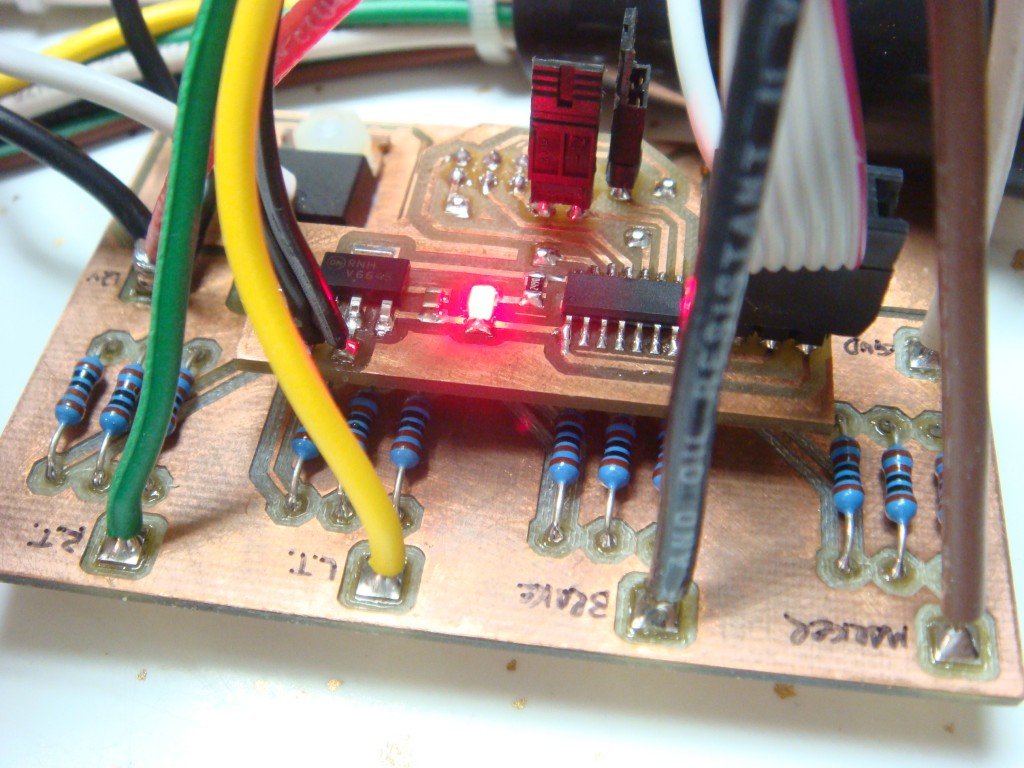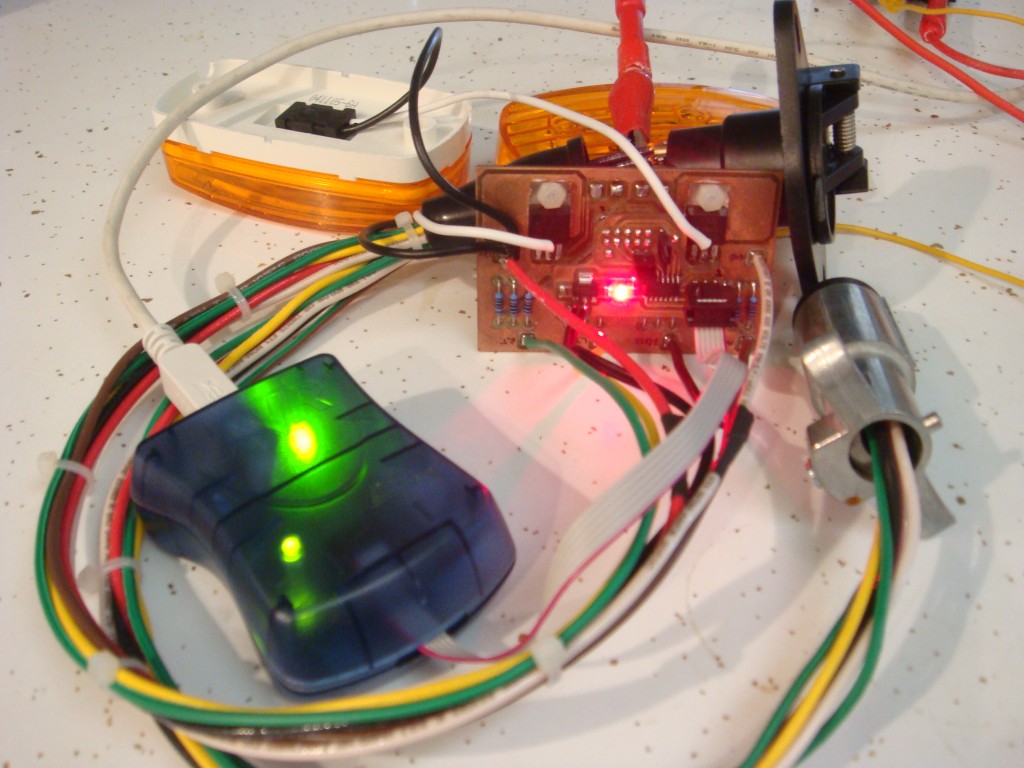Turn signals for a trailer
I’ve been working intermittently on a project to come up with a way to add turn signals to the side of a trailer without needing any extra wiring from the truck. The way people normally do this is by tapping the side markers into the turn signal wires. However, that makes the side markers turn on and off with the brakes which makes for a confusing signal. There is no shortage of patents for adding this type of capability, but they usually require a unique transmitter aboard the truck that communicates with another unique receiver on the trailer. Since the 6 pin standard is ubiquitous, that type of system will likely not be available or popular for some time. I didn’t want to add any special hardware to the truck either. So I’ve been working on a solution that taps into the trailer’s main electrical harness and creates an extra side turn signal for each side of the trailer and also functions as a clearance light.

You can use any standard clearance light and it will function as a clearance light when the lights are on, and also flash that light when the appropriate turn signal is on. The brakes will not cause the side markers to flash. You can add new lights, or simply intercept the wiring to existing clearance lights. The only modification is to the trailer, and it will work the same for any truck. The only requirement is that the trailer has electric brakes and the truck has a brake controller.
My code is running on an ATtiny24, on a board I prototyped just for this. I built an in-line harness for testing that passes the signals from the 6 pin connector to the trailer, but taps into those signals for the logic. My device has two standard LED clearance lamps attached as left and right turn signals for testing. This system is an add-on to the existing trailer wiring, so in the event of a failure nothing is compromised.

It has been tough getting this working, as there’s not exactly a manual for how the truck and the brake controller handle the signals. It’s taken a few months, as evidenced by the tarnished PCB. If I remember right I made it this summer.
17 Comments to Turn signals for a trailer
Leave a Reply
Other Stuff
Recent Posts
- 6CY7 dual triode valve amplifier
- Air quality sensor (TVOC and eqCO2)
- Automotive rear fill “surround sound” with Boss DD-3
- Spring tester / weight scale
- Ducati 749/999 Tail Light
- Instruments for the GSXR
- Light pipe tail light for the GSXR
- M17x 6990m / 6970m overheating
- PAR / Spectrum analyzer
- Acrylic polishing and scratch removal
Archives
- May 2019 (2)
- April 2017 (3)
- October 2015 (1)
- May 2015 (1)
- March 2014 (2)
- December 2013 (1)
- July 2013 (1)
- November 2012 (1)
- October 2012 (4)
- September 2012 (1)
- August 2012 (3)
- June 2012 (1)
- March 2012 (1)
- February 2012 (1)
- January 2012 (1)
- October 2011 (3)
- July 2011 (1)
- June 2011 (3)
- May 2011 (2)
- April 2011 (1)
- December 2010 (1)
- August 2010 (1)
- July 2010 (3)
- April 2010 (2)
- March 2010 (2)
- January 2010 (2)
- December 2009 (2)
- October 2009 (2)
- September 2009 (1)
- August 2009 (15)
Any chance we could get you to post your code and schematic for others to build from? A simple interpreter board like this adds a lot of functionality with little effort and a low price. Good stuff!
[…] is working to add side clearance lights to a trailer. These orange clearance lights are illuminated when the vehicle’s headlights are on to […]
This is a lot of work and point of failure addition for something that required 3 minutes with Google and 2 running taps.
http://www.etrailer.com/faq-wiring.aspx
Adam:
Sure, go try it. It doesn’t work like you think. The brake signal on a trailer harness has nothing to do with the taillights. Brake lights are made by LT+RT.
Then your trailer and truck are wired wrong.
http://www.etrailer.com/faq-wiring.aspx
Adam, your link says the same thing imsolidstate is saying.
Look at the first diagram the wires are left/stop and right/stop
That’s funny. Between myself and my parents we have 7 trailers, 3 haulers, and I work on them all. They all work perfect. What exactly makes you think I don’t know what I’m talking about?
Hi,
there are at least four different standards of trailer sockets.
The european versions have separate lines and bulbs for the turn indicators and brakes.
http://www.saabcentral.com/forums/showpost.php?s=8d0c44ff62784c7c9c74fe27e6812c9a&p=1373295&postcount=9
Thanks for posting that link. Are you sure that the “brake” signal wire in the UK is actually for the brake lights? I don’t see any pins for electric brake control, so how are you controlling the brakes then? I also find it hard to believe that there are two sets of bulbs in the taillights of the trailer, one just for turn and another for brakes. You still need one for running lights, so that would be three filaments.
Hi,
I’m positive.
Pure electromechanic brakes are not even street legal in the whole EU.
Standard are overrun brakes for lightweight trailers.
Commercial trailers have pneumatic brakes or electronically controlled (anti-lock, anti-skid etc.) hydraulic or pneumatic brakes.
Wow, I didn’t know that. Thanks for the info. All the trailers I’ve hauled here in the states have had electric brakes. As such, there isn’t a direct provision for an exclusive brake lights signal. Thanks!
wouldn’t it be easier to run a wire from your front turn signals and just add a 2nd connector
etrailer sells this product, #118158, they sell it to hook and RV to vehicle its pulling the 2 brake/turn wires are spilt into 3- lf turn signal, rt turn signal and brake
Pacman, thanks for pointing that out. I just ordered one to see if it works the same as the one I made. Too bad I didn’t know about that before, I may have been wasting my time with this project!
[…] anyone was interested in my trailer turn signal project, (there was a lot of haters on that one, esp. on Hackaday) Pacman left a comment on that […]
I am looking into using the module that is used on the Pacer performance Outback led light bar. It takes a 4 flat style wire, constant power, and reverse wire and has separate brake and turn functions.
Bob,
I was originally thinking of something like that to put on the side of the trailer, tucked just underneath the bottom edge and pointing down at the ground (sort of like ground effects for your trailer). It would get people’s attention without being annoying. There’s a nice ledge on horse trailers that would hide it well. I was just going to use an amber strip though.
If you just need to extract the turn signals from the composite signal, you’ll spend less on the module I found in my later article.